Dance and the iPad: In Step Together
ICTs have always had a certain attractiveness for teaching students how to dance. The Dance program at the Cégep de Saint-Laurent has used technological advances in the past and is continuing the tradition by integrating iPads into the practice of teaching. Marc-André Laflamme, an Editor for the French Side of Profweb interviewed Jessika, Mélanie and Caroline. He gathered and summarized their thoughts into this Real Life Story on the use of mobile tablets in the Dance program.
The Underlying Objectives for Using the iPad
In our Dance program, video capture technologies have always been an essential evaluation tool. In 2012, we designed a project to integrate tablets into the classroom. The general objectives were to:
- Verify the pedagogical potential of tablets and their applications
- Verify the possibility of integrating this type of device into the IT infrastructure of the CEGEP
- Allow students to develop their ICT skills
The objectives specific to Dance courses included:
- Centralize several tools to capture sound and images on the same device
- Facilitate the evaluation of student performances
- Allow for Teacher mobility during class time
The iPad is much more than a tool that facilitates our evaluations, it also allows the student to be more sensitive to the different facets of our discipline. Using video more frequently (which is much simpler on the iPad), the students multiply the number of viewing experiences and learn to watch themselves and watch others dance. In other words, they can gauge if their strategy to control their movement is effective. In creative terms, they also learn how to perceive different choreographic elements (a dancer’s management of physical space and time) and to develop their creative judgement. Traditionally, it was the mirror that played this role, sending the reflection of the dancer back to the dancer so that he or she may self-evaluate while engaged in the activity – to see if their leg was properly aligned or if their arms were in the right position. With video and the iPad, the student becomes totally invested and can concentrate on their performance then review it after the fact… as many times as they like!
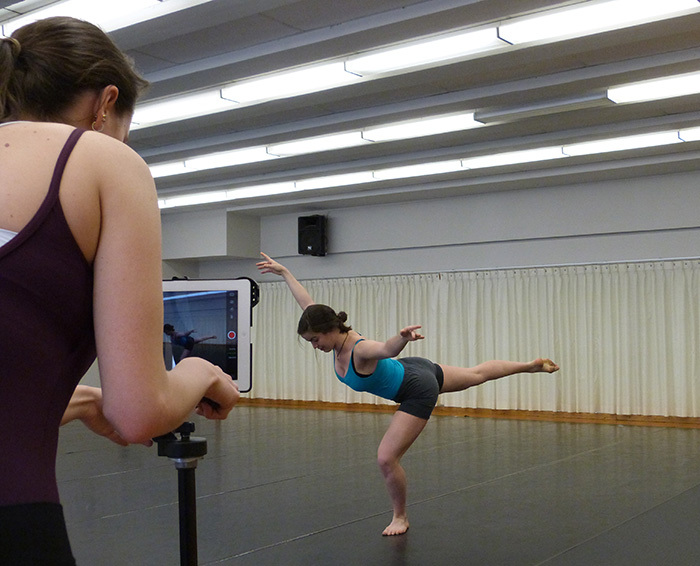
Arabesque: DesNeiges Thomas-Groulx and Jeanne Lewis (students)
Integrating the iPad into Various Courses in the Program
Starting in 2012, all of the Teachers in the program integrated the use of iPads within their classes. As each class has 15 students, and integrating the iPad was easy for classes with theory and practice sessions. The iPads used by the students had applications which were necessary to their learning pre-installed, including Coach’s Eye and Visible Body. The students could work in groups of 5, which allowed for a very functional use of the tablets. During the practice sessions, the iPads allowed students to film each other and then make adjustments to their:
- Mouvements
- Gestures
- Artistic expression
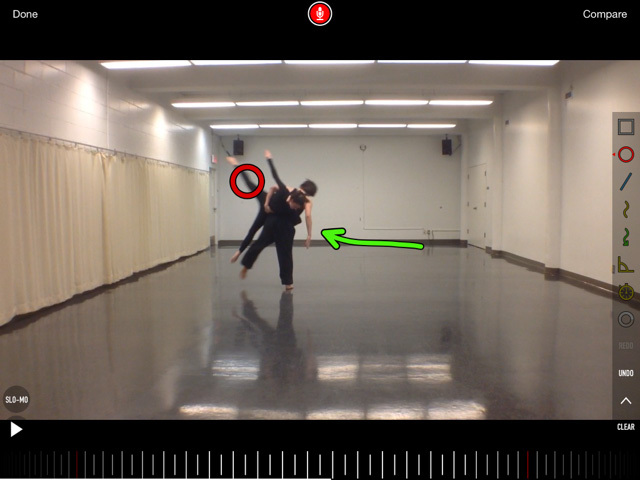
A screen capture of Coach’s Eye: Félix Martin and Catherine Nadeau (students)
The tablets are much more mobile than a traditional movie camera and offer a lot of flexibility in how they can be used, which is a definite advantage for Dance classes. Another interesting use of the tablet is that it allows all the video captures to easily be shared by e-mail. The students have the option of reviewing their performance at home, before or after a class. This allows them to scrutinize their performance in even greater detail. This practice opens the door to a flipped classroom strategy, if the Teacher so chooses.
During the theoretical aspects of the course, the iPad serves as a tool to support learning about anatomy with the Visual Body app which has interactive cross-sections of the body. What’s more, the iPad’s use in the class Study of an Artistic Phenomena: Dance (Étude d’un phénomène artistique : la danse) greatly facilitates the viewing of widely renowned choreographed works. To round out the use of iPads, the comprehensive assessment for the program is a time at which students are asked to use all of the notions of choreographic composition that they have learned during their studies and sculpt it into a performance. These notions demand a great deal of time and finesse. The iPad is very flexible and can cater to the needs of different types of students. Think of students that have an attention deficit or who have other specific needs that require them to have access to adaptive educational technologies.
A Partial Report on the Use of iPads By Teachers and Students
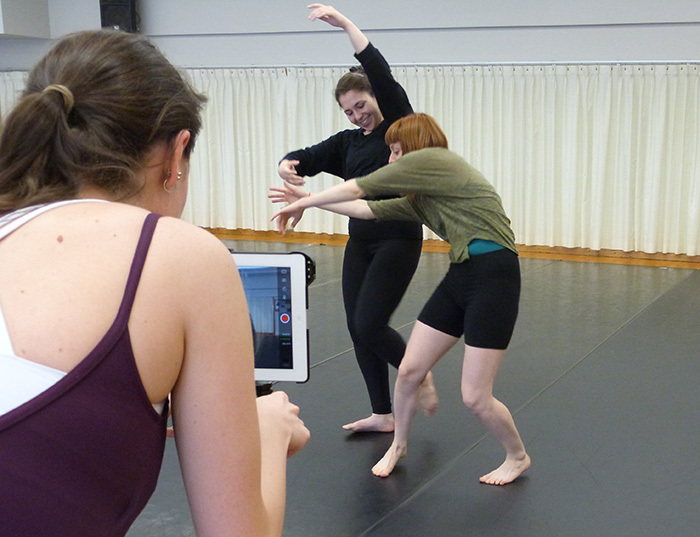
Improvization : DesNeiges Thomas-Groulx, Valérie Hard and Élie Mainville (students)
In general, we are all very taken with the iPad and its usefulness, and more specifically with the Coach’s Eye app. The courses have more active learning, increased interactivity and self-evaluation has been facilitated. This means that students are more attentive to details and able to analyse their performance. What’s more, the iPad’s flexibility allows us to flip the classroom where appropriate, which develops other aspects of learning. They are also a substantial tool for evaluation, since videos can be annotated thanks to the Coach’s Eye app. But, since there are two sides to every coin, we should mention that the iPad also poses a few challenges. The apps change regularly due to ongoing updates, which requires a considerable time investment and a certain amount of adaptation by both students and teachers. As well, we have been testing various options to project from the iPad to a screen and to share videos in the classroom, with mixed results. The search for solutions to these problems are ongoing.
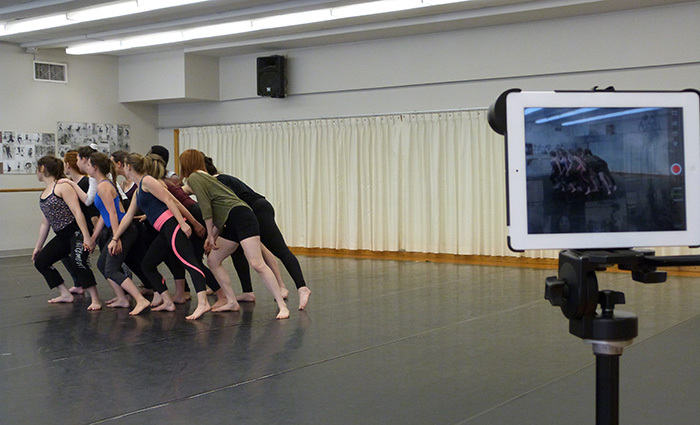
Students: Sandra Côté-St-Germain, Aude Lavergne, Ophélie Dubois, Amélie Lajoie, DesNeiges Thomas-Groulx, Florence Lacroix, Pierre-Rodrigue Kwemi, Catherine Hotte, Valérie Hard, Élie Mainville, Jeanne Lewis, Alexia-Anne Quintin.
We did 2 surveys in 2013 to get a better idea of how the students felt about using iPads in class. What they told us was that the iPad:
- Is very user-friendly and enjoyable to use.
- Allows for feedback and tailored follow-up for students from their Teachers.
- Using photo and videos helps students to analyse posture, detect errors more easily and self-evaluate.
- Helps to prepare for examinations.
- Facilitates sharing of videos for educational use between students.
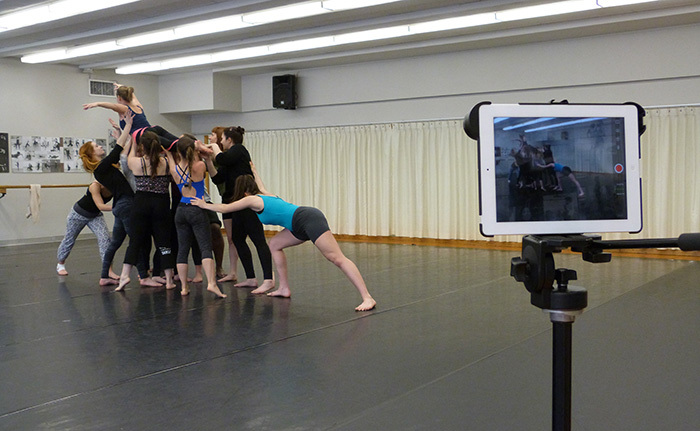
Students: Sandra Côté-St-Germain, Aude Lavergne, Ophélie Dubois, Amélie Lajoie, DesNeiges Thomas-Groulx, Florence Lacroix, Pierre-Rodrigue Kwemi, Catherine Hotte, Valérie Hard, Élie Mainville, Jeanne Lewis, Alexia-Anne Quintin.
In closing, we’d like to acknowledge the commitment of the Cégep de Saint-Laurent, which enthusiastically supported the iPad project. The CEGEP not only provided the necessary equipment, but also some of the fundamental support. Despite being a recent project, our exploration of the iPad is fairly advanced, and our findings are very positive, as much from the standpoint of the teachers as those of the students. The experimental phase of the project was implemented in the fall of 2014. We would now like to evaluate the impact of the use of the iPad on student success for the students enrolled in the Dance program. Would you like to know more about this project? We’d be happy to hear your comments and respond to your questions.

